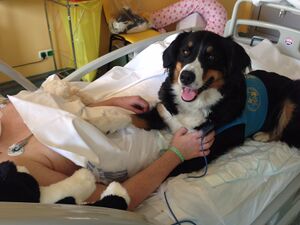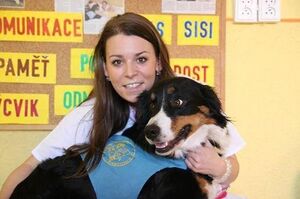Canistherapy
The term Canistherapy („Canis” – dog a „therapy” – treatment) has appeared in the Czech Republic since the early 1990s. The pioneers of this form of therapy include, for example, Prof. Matejček. It is a method of rehabilitation using the relationship between a person and a dog. For this form of therapy, it is necessary that the dog is properly trained and prepared. There are several forms of canistherapy, which can be conducted by both a layman and a professional, but the necessary prerequisite remains the demonstration of the dog's skills in special tests.
History[edit | edit source]
It is historically documented that the dog, as an animal capable of distinguishing between good and evil, was already worshiped by the inhabitants of Persia and ancient Egypt. Among the Persian customs was the presence of a dog at the bedside of the dying person so that he could look the dog in the eye. In Babylon, they believed that dog saliva has a significant healing effect, which can be compared to the effect of antibiotics. In the Middle Ages, people used the help of dogs in the treatment of rheumatism, when they were placed next to the sick to warm their musculoskeletal system and thereby relieve their pain. In the 19th century, dogs began to be used in the treatment of mental illnesses. Since the 20th century, treatment with the help of dogs has been more precisely specified, the first concepts are created, and canistherapy begins to be used to help treat physically disabled children. In 1990, the international organization Canistherapy was founded.
Forms of Canistherapy[edit | edit source]
- Guided by a professional (psychologist, doctor, teacher, physiotherapist and others),
- led by a layperson in cooperation with professionals.
The mentioned second type takes place, for example, in Motol General Hospital and other hospitals. The volunteer receives special training and must cooperate fully with the ward staff, but does not perform actual therapy. It is rather a form of detachment from the stereotype and cheering up the patient.
The Healing Effect of Canistherapy[edit | edit source]
There are two levels of positive therapeutic effects of a therapy dog on a person, physical and psychological. The fact that a dog has a temperature about one degree higher than a human is used, and when positioned near the patient, the muscles warm up, which can positively affect blood circulation and relieve muscle spasms. Contact with dog fur can also have a beneficial effect. Above all, the dog helps with the stimulation of movement and rehabilitation in children's patients. On a psychological level, a dog can act as a friend and companion.
Canistherapy can be aimed at:
- development of motor skills (fine and gross motor skills),
- development of better emotional skills (stroking, cuddling, communication with the dog),
- development of mental abilities (game, improving vocabulary),
- ability to relax (mental balance).
References[edit | edit source]
External links[edit | edit source]
Literature[edit | edit source]
- GALAJDOVÁ, Lenka – GALAJDOVÁ, Zdenka. Canisterapie : pes lékařem lidské duše. 1. edition. Praha : Portál, 2011. 167 pp. ISBN 978-80-7367-879-1.
- Občanské sdružení Pes pomůže. Terapeutický pes [online]. ©2005. [cit. 2013-06-02]. <http://www.pes-pomuze.com/terapeuticky_pes.html>.


